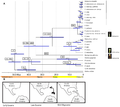Category:Sarraceniaceae
| Sarraceniaceae Temporal range: Early Cretaceous – recent
| |
|---|---|

| |
| Heliamphora chimantensis | |
| Scientific classification | |
| Kingdom: | |
| (unranked): | |
| (unranked): | |
| (unranked): | |
| Order: | |
| Family: | Sarraceniaceae |
| Genera | |
The Sarraceniaceae are a family of pitcher plants, belonging to order Ericales (previously Nepenthales).
The family comprises three extant genera: Sarracenia (North American pitcher plants), Darlingtonia (the cobra lily or California pitcher plant), and Heliamphora (sun pitchers).[1][2] The extinct Archaeamphora longicervia may also belong to this family.[3] All three are carnivorous plants that lure insects with nectar and use their elongated, tube-shaped leaves filled with water and digestive enzymes to catch and consume them. Digestive enzymes are not always produced by the plants themselves. Digestive mutualisms are common in Sarraceniaceae: both Sarracenia and Darlingtonia rely on commensal bacteria to supplement or produce all of their enzymes.[4] Many species also use downward-pointing hairs and waxy secretions to make it difficult for insects to escape.
Sarracenia and Darlingtonia are native to North America, while Heliamphora is native to South America. Phylogenetic analysis suggests that the family originated in South America about 47 million years ago and spread to North America soon after, about 35 million years ago.[5] The Sarracenia and Heliamphora clade diverged from Darlingtonia around this time, most likely due to a cooling event at the beginning of the Oligocene.[5] Sarracenia diverged from Heliamphora later, around 23 million years ago.[5]
These plants grow in nutrient-poor, often acidic soil and use the insects as a nutritional supplement. As such, growth of carnivorous pitchers is plastic: as soil nitrogen increases, Sarracenia produces fewer pitchers.[6] The pitchers originate from a rhizome and die back during the winter dormancy. Plants of the genus Sarracenia occur mostly in Sphagnum bogs.
Most Sarraceniaceae have tall, narrow pitchers that are vertical or nearly so. Sarracenia purpurea, however, has short, squat, bulbous pitchers close to the ground, and Sarracenia psittacina has pitchers that grow horizontally.
The purple pitcher plant (Sarracenia purpurea) is the official flower of Newfoundland and Labrador.
Archaeamphora longicervia, extinct
Combined nuclear, plastid and mitochondrial phylogeny of Sarraceniaceae[7]
References
- ↑ McPherson, S. & D. Schnell 2011. Sarraceniaceae of North America. Redfern Natural History Productions Ltd., Poole.
- ↑ McPherson, S., A. Wistuba, A. Fleischmann & J. Nerz 2011. Sarraceniaceae of South America. Redfern Natural History Productions Ltd., Poole.
- ↑ Li, H. 2005. "Early Cretaceous sarraceniacean-like pitcher plants from China" (PDF). (2.84 MiB) Acta Bot. Gallica 152(2): 227-234.
- ↑ Anderson, B., and J. J. Midgley. 2003. Digestive mutualism, an alternate pathway in plant carnivory. Oikos 102:221-224.
- ↑ 5.0 5.1 5.2 Ellison, A. M., E. D. Butler, E. J. Hicks, R. F. C. Naczi, P. J. Calie, C. D. Bell, and C. C. Davis. 2012. Phylogeny and biogeography of the carnivorous plant family Sarraceniaceae. Public Library of Science One 7:e39291.
- ↑ Ellison, A. M. and N. J. Gotelli. 2002. Nitrogen availability alters the expression of carnivory in the northern pitcher plant, Sarracenia purpurea. Proceedings of the National Academy of Sciences of the United States of America 99:4409-4412.
- ↑ Ellison, A.M., E.D. Butler, E.J. Hicks, R.F.C. Naczi, P.J. Calie, C.D. Bell & C.C. Davis 2012. Phylogeny and biogeography of the carnivorous plant family Sarraceniaceae. PLoS ONE 7(6): e39291. doi:10.1371/journal.pone.0039291
- Sarraceniaceae in L. Watson and M.J. Dallwitz (1992 onwards). The families of flowering plants.
- D’Amato, Peter, The Savage Garden: Cultivating Carnivorous Plants, Berkeley 1998, ISBN 0-89815-915-6
Acknowledgements
This article uses material from the Wikipedia article Sarraceniaceae, which is released under the Creative Commons Attribution-Share-Alike License 3.0.
This category currently contains no pages or media.





